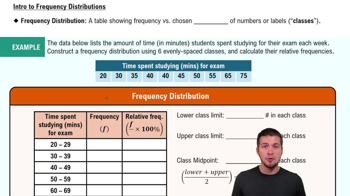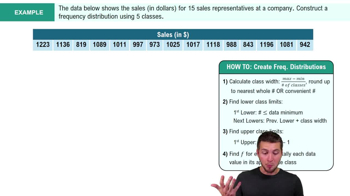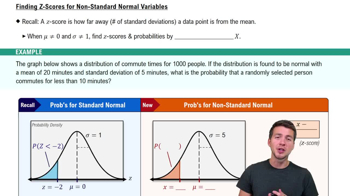Boston Commute Time The accompanying table summarizes daily commute times in Boston. How many commute times are included in the summary? Is it possible to identify the exact values of all of the original data amounts?
Table of contents
- 1. Intro to Stats and Collecting Data1h 14m
- 2. Describing Data with Tables and Graphs1h 55m
- 3. Describing Data Numerically2h 5m
- 4. Probability2h 16m
- 5. Binomial Distribution & Discrete Random Variables3h 6m
- 6. Normal Distribution and Continuous Random Variables2h 11m
- 7. Sampling Distributions & Confidence Intervals: Mean3h 23m
- Sampling Distribution of the Sample Mean and Central Limit Theorem19m
- Distribution of Sample Mean - Excel23m
- Introduction to Confidence Intervals15m
- Confidence Intervals for Population Mean1h 18m
- Determining the Minimum Sample Size Required12m
- Finding Probabilities and T Critical Values - Excel28m
- Confidence Intervals for Population Means - Excel25m
- 8. Sampling Distributions & Confidence Intervals: Proportion1h 12m
- 9. Hypothesis Testing for One Sample3h 29m
- 10. Hypothesis Testing for Two Samples4h 50m
- Two Proportions1h 13m
- Two Proportions Hypothesis Test - Excel28m
- Two Means - Unknown, Unequal Variance1h 3m
- Two Means - Unknown Variances Hypothesis Test - Excel12m
- Two Means - Unknown, Equal Variance15m
- Two Means - Unknown, Equal Variances Hypothesis Test - Excel9m
- Two Means - Known Variance12m
- Two Means - Sigma Known Hypothesis Test - Excel21m
- Two Means - Matched Pairs (Dependent Samples)42m
- Matched Pairs Hypothesis Test - Excel12m
- 11. Correlation1h 6m
- 12. Regression1h 50m
- 13. Chi-Square Tests & Goodness of Fit1h 57m
- 14. ANOVA1h 57m
2. Describing Data with Tables and Graphs
Frequency Distributions
Problem 2.1.14
Textbook Question
Presidents Listed below are the ages (years) of presidents of the United States at the times of their first inaugurations (from Data Set 22 “Presidents” in Appendix B). Presidents who took office as a result of an assassination or resignation are not included. The data are current as of this writing. Use these ages to construct a frequency distribution. Use a class width of 5 years and begin with a lower class limit of 40 years. Do the ages appear to have a normal distribution?

 Verified step by step guidance
Verified step by step guidance1
Step 1: Organize the data by listing the ages of the presidents at their first inauguration. The ages provided are: 57, 61, 57, 57, 61, 64, 48, 49, 64, 52, 46, 49, 47, 55, 42, 51, 56, 51, 54, 60, 62, 43, 55, 56, 52, 69, 46, 54, 47, 70.
Step 2: Determine the range of the data by identifying the minimum and maximum ages. The minimum age is 42 and the maximum age is 70.
Step 3: Create the class intervals for the frequency distribution. Start with a lower class limit of 40 years and use a class width of 5 years. The classes will be: 40-44, 45-49, 50-54, 55-59, 60-64, 65-69, and 70-74.
Step 4: Count the number of ages that fall into each class interval to construct the frequency distribution. For example, count how many ages fall between 40 and 44, then 45 and 49, and so on.
Step 5: Analyze the frequency distribution to determine if the ages appear to have a normal distribution. A normal distribution typically has a bell-shaped curve, so check if the frequencies increase to a peak and then decrease symmetrically.
 Verified video answer for a similar problem:
Verified video answer for a similar problem:This video solution was recommended by our tutors as helpful for the problem above
Video duration:
4mPlay a video:
Was this helpful?
Key Concepts
Here are the essential concepts you must grasp in order to answer the question correctly.
Frequency Distribution
A frequency distribution is a summary of how often each value occurs in a dataset. It organizes data into classes or intervals, allowing for easier analysis of patterns and trends. In this case, the ages of U.S. presidents will be grouped into intervals of 5 years, starting from 40, to visualize the distribution of ages at inauguration.
Recommended video:
Guided course

Intro to Frequency Distributions
Class Width
Class width refers to the range of values that each class in a frequency distribution covers. It is calculated by subtracting the lower limit of a class from its upper limit. For this question, a class width of 5 years means that each age group will encompass a range of 5 years, such as 40-44, 45-49, and so on, facilitating the organization of the data.
Recommended video:
Guided course

How to Create Frequency Distributions Example 2
Normal Distribution
A normal distribution is a probability distribution that is symmetric about the mean, showing that data near the mean are more frequent in occurrence than data far from the mean. To determine if the ages of presidents exhibit a normal distribution, one would analyze the frequency distribution for symmetry and the presence of a bell-shaped curve, indicating that most ages cluster around the average.
Recommended video:
Guided course

Finding Z-Scores for Non-Standard Normal Variables

 6:38m
6:38mWatch next
Master Intro to Frequency Distributions with a bite sized video explanation from Patrick
Start learningRelated Videos
Related Practice
Textbook Question
